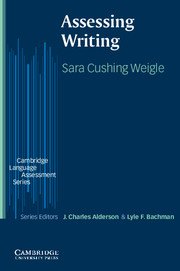Book contents
- Frontmatter
- Contents
- Series Editors' Preface
- Acknowledgements
- 1 Introduction
- 2 The nature of writing ability
- 3 Basic considerations in assessing writing
- 4 Research in large-scale writing assessment
- 5 Designing writing assessment tasks
- 6 Scoring procedures for writing assessment
- 7 Illustrative tests of writing
- 8 Beyond the timed impromptu test: Classroom writing assessment
- 9 Portfolio assessment
- 10 The future of writing assessment
- Bibliography
- Index
1 - Introduction
Published online by Cambridge University Press: 03 May 2010
- Frontmatter
- Contents
- Series Editors' Preface
- Acknowledgements
- 1 Introduction
- 2 The nature of writing ability
- 3 Basic considerations in assessing writing
- 4 Research in large-scale writing assessment
- 5 Designing writing assessment tasks
- 6 Scoring procedures for writing assessment
- 7 Illustrative tests of writing
- 8 Beyond the timed impromptu test: Classroom writing assessment
- 9 Portfolio assessment
- 10 The future of writing assessment
- Bibliography
- Index
Summary
The ability to write effectively is becoming increasingly important in our global community, and instruction in writing is thus assuming an increasing role in both second-and foreign-language education. As advances in transportation and technology allow people from nations and cultures throughout the world to interact with each other, communication across languages becomes ever more essential. As a result, the ability to speak and write a second language is becoming widely recognized as an important skill for educational, business, and personal reasons. Writing has also become more important as tenets of communicative language teaching – that is, teaching language as a system of communication rather than as an object of study – have taken hold in both second-and foreign-language settings. The traditional view in language classes that writing functions primarily to support and reinforce patterns of oral language use, grammar, and vocabulary, is being supplanted by the notion that writing in a second language is a worthwhile enterprise in and of itself.
Wherever the acquisition of a specific language skill is seen as important, it becomes equally important to test that skill, and writing is no exception. Thus, as the role of writing in second-language education increases, there is an ever greater demand for valid and reliable ways to test writing ability, both for classroom use and as a predictor of future professional or academic success.
What does it mean to test writing ability? A common-sense answer to this question is that “the best way to test people's writing ability is to get them to write” (Hughes, 1989: 75).
Information
- Type
- Chapter
- Information
- Assessing Writing , pp. 1 - 13Publisher: Cambridge University PressPrint publication year: 2002
